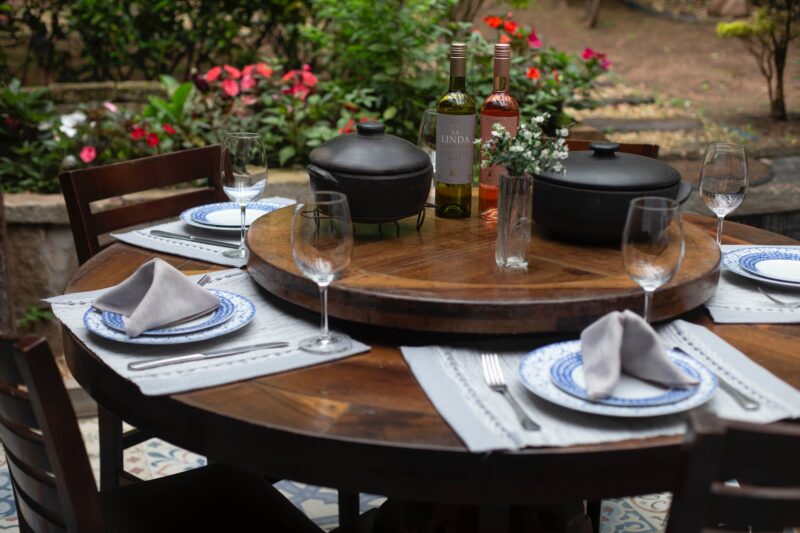When it comes to gathering around the dinner table, there’s more than meets the eye. Beyond the delicious food and lively conversation, the dinner table has a rich history and cultural significance that has evolved over time. Join us as we take a journey through the fascinating world of the dinner table.
The Origins of the Dinner Table

The concept of the dinner table can be traced back to ancient civilizations. In ancient Egypt, for example, the pharaohs would host elaborate banquets where guests would recline on couches and enjoy a variety of dishes. The ancient Greeks and Romans also had their own versions of the dinner table, where social status and etiquette played a significant role.
The earliest known dining tables were found in ancient Egypt, where dining tables were used by the wealthy to display their wealth and status. They were often made from wood or metal and were intricately carved and decorated. The tables were rectangular or oval in shape and were supported by four legs. They were often adorned with carvings of hieroglyphics and other decorative motifs. The tables were used to serve food and drinks and were also used for socialising and entertainment. The wealthy would often host banquets and feasts on their dining tables and would invite their friends and guests to dine with them. The tables were also used for religious ceremonies and rituals.
As time went on, the dinner table became more than just a place to eat. It became a symbol of hospitality, community, and family. In medieval times, the dining table was often the centrepiece of the household, where families would gather to share a meal and bond with one another.
The Evolution of Table Manners

Table manners have also played a crucial role in the history of the dinner table. In medieval times, for example, it was common for people to eat with their hands, as utensils were not widely used. However, as society became more refined, table manners became more important.
The 17th and 18th centuries saw the rise of elaborate dining etiquette, with rules on how to hold utensils, how to sit, and even how to interact with fellow diners. These rules were often strict and dictated by social class, with the upper class having more elaborate and formal dining rituals.
Today, while table manners may not be as strict as they once were, they still play a role in our dining experiences. From knowing which fork to use to understanding the proper way to pass dishes, good table manners can make a meal more enjoyable and create a sense of harmony among diners.
The Cultural Significance of the Dinner Table
Across different cultures, the dinner table holds a special place. It is a space where traditions are passed down, stories are shared, and relationships are strengthened. In many cultures, the act of sharing a meal is seen as a way to connect with others and show hospitality.
In Italy, for example, the dinner table is a sacred space where families come together to enjoy a leisurely meal. In Japan, the traditional dining table is low to the ground, encouraging a sense of intimacy and togetherness. In India, meals are often eaten with the hands, symbolizing a close connection between the food and the person consuming it.
Even in modern times, the dinner table continues to evolve. With the rise of technology, it’s not uncommon to see families and friends gathered around the table, but with their attention focused on their smartphones instead of each other. While technology has its benefits, it’s important to remember the value of face-to-face interaction and the power of a shared meal.
Creating Meaningful Moments
The history and culture of the dinner table can inspire us to create meaningful moments in different ways. For example, we can learn from the past how different civilizations used their tables to express their values, beliefs, customs, and rituals. We can also learn from the present how different cultures use their tables to celebrate their diversity, creativity, and identity. We can also learn from the future how different trends will shape our dining habits and preferences.
So, how can we make the most of our dinner table experiences? By creating meaningful moments. Whether it’s trying a new recipe, sharing stories from the day, or simply enjoying each other’s company, the dinner table is a place where memories are made.
Consider setting aside dedicated time for family meals, free from distractions. Use this time to reconnect, share laughter, and create a sense of belonging. Experiment with different cuisines and flavours to expand your culinary horizons. And most importantly, savour the experience of coming together over a meal.
The dinner table is more than just a place to eat. It’s a symbol of our shared humanity, a reminder of the importance of connection, and a celebration of our diverse cultures and traditions. So, let’s raise a glass and toast to the history and culture of the dinner table.
Conclusion
The dinner table is more than just a piece of furniture. It is a reflection of the history and culture of the people who use it. From ancient Egypt to the modern day, the dinner table has evolved with the changing times, adapting to the needs and preferences of different societies and civilizations. The dinner table is also a place of social interaction and communication, where people gather to share food, stories, and emotions. The dinner table is, therefore, a symbol of human creativity, ingenuity, and connection.
Frequently Asked Question
The dinner table holds a special place in many cultures as it is a symbol of togetherness and unity. It is where families and friends gather to share a meal, engage in conversation, and strengthen their bonds. The dinner table is not just a place to eat, but also a space for storytelling, laughter, and creating lasting memories.
The dinner table has evolved significantly throughout history. In ancient times, people would sit on the floor or on low stools to eat. As societies progressed, tables became more common and were made from various materials such as wood, stone, and metal. Today, we have a wide range of dining tables in different shapes, sizes, and designs to suit our individual tastes and needs.
Absolutely! Many cultures have unique customs and traditions related to dining. For example, in Japan, it is customary to say “itadakimasu” before a meal as a way of expressing gratitude. In Italy, it is considered rude to ask for cheese to be added to a seafood dish. These practices vary across the globe and add to the richness of our dining experiences.
The dinner table often reflects a society’s values and norms. For instance, in some cultures, it is important to wait for everyone to be seated before starting a meal, highlighting the value of patience and consideration for others. Additionally, the types of food served and the manner in which they are consumed can also reflect cultural beliefs and traditions.
Certainly! Did you know that the concept of using a tablecloth originated in ancient Egypt? They would spread a cloth on the ground to keep the sand and dirt away from their food. Also, the use of forks at the dinner table was once considered controversial and even seen as a sign of decadence in some societies.











